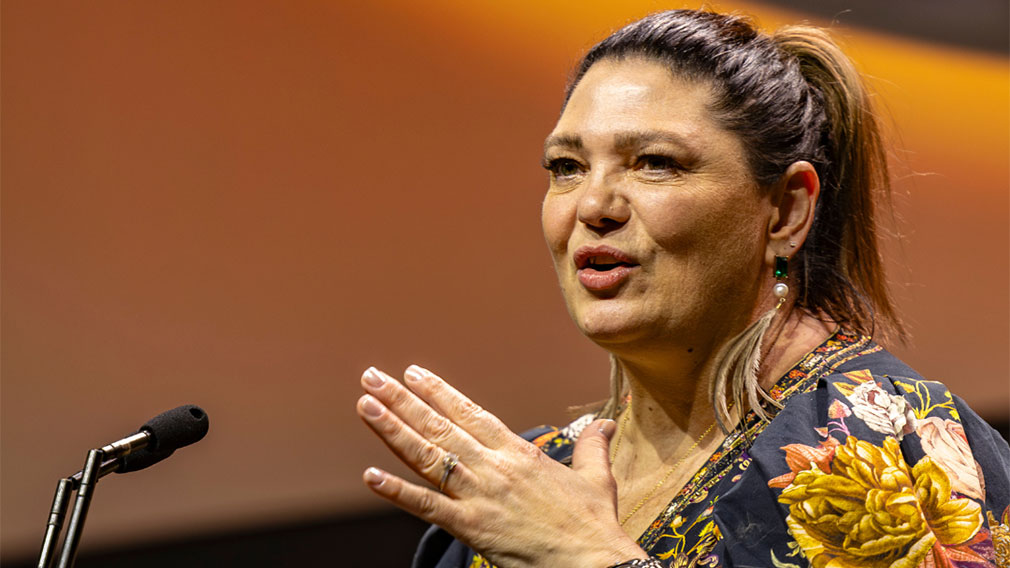Art an enabler to a winning corporate culture

Leanne Bennett (L), wife of the late artist Gordon Bennett, discusses the ‘Possession Island (Abstraction) 1991’ painting with Qantas CEO Alan Joyce and Simon Mordant (R) at the Museum of Contemporary Art Australia. (Getty)
More than 40 years ago, I bought my first picture, a small colour etching of a house in a field titled “The Hangman’s House” at the Royal Academy annual summer exhibition.
It was a beautiful work and intrigued me. I was so taken by the image that I wrote to the artist and asked her to explain the work to me. Her response remains attached to the back of the frame.
That began my journey with collecting art, something that has continued for more than 40 years – I have only ever sold one work in order to buy another picture by the same artist.
While that wasn’t my first memory of engaging with creativity, it was certainly a key turning point, and since then I have become absorbed by the creative process, and the arts have become central in my life – both in business and other activities.
I have filled our offices and homes with contemporary art from around the world. The response from clients and team members has been extraordinary. The varying works stimulate different responses and challenge the viewer to inquire and question.
We live in a rapidly changing world – the most fast changing environment that has ever been seen. The population has doubled in the last 30 years and the rate of urbanisation has accelerated rapidly. Successful businesses must adapt to these changes to thrive. For me, creativity is central to this – it is the key first step to innovation and successful business leaders must evolve their organisations to be creative.
The smartphone we all carry with us today has more computing power than was on the entire planet in 1940, and the average digital watch has more computing power than the 1969 Apollo Moonlander that carried Neil Armstrong to the moon, enabling him to make that first small step and giant leap for mankind, and return him safely to earth.
An IBM survey of 1500 chief executive officers from 66 countries and 33 industries noted that successfully navigating an increasingly complex world requires creativity ahead of any other factor.
This was borne out in a 2014 Forrester Consulting Survey of 324 decision makers globally that demonstrated that companies which embrace creativity outperform their peers and competitors in the key metrics of revenue growth, market share and talent acquisition. They enjoy a high performance working environment, driven by progressive leaders who support a creative culture. These companies were more collaborative, had deeper relationships with their customers and made significant investments and resourcing in developing a creative culture across the firm.
Creativity is so critical as it fuels big ideas, challenges conventional thinking and opens the door to innovation.
Surrounding myself with art and spending time with visual and performing artists stimulates the right side of my brain – the side that enables imagination, day dreaming, intuition and creativity. The left side of the brain enables logic, dealing with facts, analytics and maths. These two sides need to be stimulated – but all too often we focus on the left.
As Sir Ken Robinson, a noted international leader in the development of creativity and imagination in education and business, has observed, imagination is the process of bringing to mind things that are not present to our senses; creativity is the process of developing original ideas that have value and innovation is the process of putting new ideas into practise. Creativity is thus essential to innovation.
He notes the key role of creative leaders is to firstly facilitate the creative abilities of every member of the organisation, secondly to form and facilitate dynamic and creative teams and thirdly to promote a general culture of innovation. He notes that creative organisations give people freedom to take risks, allow people to discover and develop their natural intelligence -- there are no stupid questions and no right answers, the organisation values irreverence, the lively, the dynamic, the surprising and the playful. How exciting is that!
In my view, business should leverage skills available from artists and the creative communities. The relationship between business and the arts needs to advance from the traditional relationship of entertainment and sponsorship to a new level of collaboration where the arts community can help stimulate a culture of creativity within business.
As Harvard and Cornell professors Teresa Amabile and Mukti Khaire said: “One doesn’t manage creativity, one manages for creativity. The role as a leader is to create a working environment in which critical thinking, new ideas and creative solutions can flow freely.”
The Museum of Contemporary Art Australia, which I chair, has seen the opportunity of collaborating with business to create a program to stimulate creativity and innovation. Held in the National Centre for Creative Learning, the MCA Artist Educators run half day workshops tailored to corporate clients’ needs utilising creative learning strategies that respond to exhibitions and artworks at the Museum. These interactive and immersive workshops give corporate participants the opportunity to explore core skills in developing a creative culture. Communication, collaboration, problem solving, creativity and lateral thinking are explored at each workshop.
As I first discovered over 40 years ago, contemporary art is an enabler and the more we can do to showcase the benefits and encourage business to engage with the arts, the better.
The views expressed are those of the author and do not necessarily reflect those of the Westpac Group.



